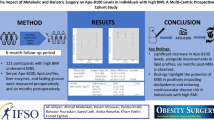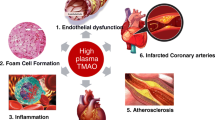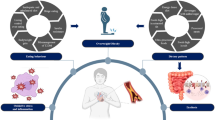Abstract
Purpose
The oxidative stress plays a key role in the initiation, propagation, and development of the complications of type 2 diabetes mellitus (T2DM). This trial aimed to evaluate the effects of resistant dextrin as a prebiotic on the cardiometabolic risk factors and the status of oxidative stress in patients with T2DM.
Methods
Sixty-five female subjects with T2DM were assigned to either the intervention (n = 33) or control (n = 32) groups receiving 10 g/day of resistant dextrin or placebo, respectively, for 8 weeks. Fasting blood samples were collected at baseline and post-intervention to determine the serum levels of glycemic indices, lipid profile, atherogenic indices, and soluble receptor for AGEs (sRAGE), carboxymethyl lysine (CML), pentosidine, malondialdehyde (MDA), 8-iso-prostaglandin F2α (8-iso-PGF2α), total antioxidant capacity (TAC), antioxidant enzymes activity, and uric acid. Data were analyzed using SPSS software 17. Paired, unpaired Student’s t tests, and analysis of covariance were used to compare the quantitative variables.
Results
Resistant dextrin caused a significant decrease in FPG (− 17.43 mg/dl, 9.80%), TG (− 40.25 mg/dl, 23.01%), TC/HDL (− 0.80, 21.87%), LDL-c/HDL-c (− 0.80, 17.85%), Atherogenic index (− 0.40, 15.80%), LPS (− 6.5 EU/ml, 23.40%) and hs-CRP (− 8.02 ng/ml, 54.00%), MDA (− 1.21 nmol/mL, 25.58%), CML (− 93.40 ng/ml, 26.30%), 8-iso-PGF2α (− 4.65 pg/ml, 15.00%), and a significant increase in TAC (0.33 mmol/L, 36.25%) and s-RAGE (2.10 ng/ml, 28.90%) in the intervention group compared with the control group. No significant changes were observed in glycosylated hemoglobin, total cholesterol, LDL-c, HDL-c, superoxide dismutase, glutathione peroxidase and catalase, pentosidine, and uric acid in the intervention group compared with the control group.
Conclusions
Supplementation with resistant dextrin may improve the advanced glycation end-products, sRAGE, and cardiometabolic risk factors in women with type 2 diabetes mellitus.


Similar content being viewed by others
Abbreviations
- AGEs:
-
Advanced glycation end-products
- ANCOVA:
-
Analysis of covariance
- CML:
-
Carboxymethyl lysine
- ELISA:
-
Enzyme-linked immunosorbent assay
- GLP-1:
-
Glucagon-like peptide1
- GSH-Px:
-
Glutathione peroxidase
- GSSG:
-
Reduced oxidized glutathione
- HbA1c:
-
Glycosylated hemoglobin
- HMG-CoA:
-
3-hydroxy-3-methylglutaryl-CoA
- HOMA-IR:
-
Homeostatic Model Assessment for Insulin Resistance
- hs-CRP:
-
High-sensitivity C-reactive protein
- IDF:
-
International diabetes federation
- LPS:
-
Lipopolysaccharide
- MAPK:
-
Mitogen-activated protein kinase
- MDA:
-
Malondialdehde
- NF-κB:
-
Factor κB
- PYY:
-
Peptide YY
- RAS:
-
Random allocation software
- ROS:
-
Reactive oxygen species
- SCFA:
-
Short-chain fatty acids
- SOD:
-
Superoxide dismutase
- sRAGE:
-
Soluble receptor of advanced glycation end-products
- T2DM:
-
Type 2 diabetes mellitus
- TAC:
-
Total antioxidant capacity
- TBA:
-
Thiobarbituric acid
- TLR 4:
-
Toll-like receptor 4
- TNF-α:
-
Tumor necrosis factor-alpha
References
Cho NH, Shaw JE, Karuranga S, Huang Y, da Rocha Fernandes JD, Ohlrogge AW, Malanda B (2018) IDF Diabetes Atlas: global estimates of diabetes prevalence for 2017 and projections for 2045. Diabetes Res Clin Pract 138:271–281. https://doi.org/10.1016/j.diabres.2018.02.023
Namayandeh SM, Karimi A, Fallahzadeh H, Rahmanian M, Bafghi SM, Soltani M, Hadiani L (2019) The incidence rate of diabetes mellitus (type II) and its related risk factors: a 10-year longitudinal study of Yazd Healthy Heart Cohort (YHHC), Iran. Diab Metabol Syndr Clin Res Rev 13(2):1437–1441. https://doi.org/10.1016/j.dsx.2019.02.012
Incalza MA, D’Oria R, Natalicchio A, Perrini S, Laviola L, Giorgino F (2018) Oxidative stress and reactive oxygen species in endothelial dysfunction associated with cardiovascular and metabolic diseases. Vascul Pharmacol 100:1–9. https://doi.org/10.1016/j.vph.2017.05.005
Marciano F, Vajro P (2017) Oxidative stress and gut microbiota. In: Gracia-Sancho J (ed) Gastrointestinal tissue. Academic Press, New York, pp 113–123. https://doi.org/10.1016/B978-0-12-805377-5.00008-4
Koska J, Saremi A, Howell S, Bahn G, De Courten B, Ginsberg H, Beisswenger PJ, Reaven PD (2018) Advanced glycation end products, oxidation products, and incident cardiovascular events in patients with type 2 diabetes. Diabetes Care 41(3):570–576. https://doi.org/10.2337/dc17-1740
Robson R, Kundur AR, Singh I (2018) Oxidative stress biomarkers in type 2 diabetes mellitus for assessment of cardiovascular disease risk. Diab Metabol Syndr Clin Res Rev 12(3):455–462. https://doi.org/10.1016/j.dsx.2017.12.029
Larsen N, Vogensen FK, Van Den Berg FW, Nielsen DS, Andreasen AS, Pedersen BK, Al-Soud WA, Sørensen SJ, Hansen LH, Jakobsen M (2010) Gut microbiota in human adults with type 2 diabetes differs from non-diabetic adults. PLoS One 5(2):9085. https://doi.org/10.1371/journal.pone.0009085
Qing R, Huang Z, Tang Y, Xiang Q, Yang F (2017) Cordycepin negatively modulates lipopolysaccharide-induced cytokine production by up-regulation of heme oxygenase-1. Int Immunopharmacol 47:20–27. https://doi.org/10.1016/j.intimp.2017.03.002
Ohtsu A, Shibutani Y, Seno K, Iwata H, Kuwayama T, Shirasuna K (2017) Advanced glycation end products and lipopolysaccharides stimulate interleukin-6 secretion via the RAGE/TLR4-NF-κB-ROS pathways and resveratrol attenuates these inflammatory responses in mouse macrophages. Exp Ther Med 14(5):4363–4370. https://doi.org/10.3892/etm.2017.5045
Pasman W, Wils D, Saniez MH, Kardinaal A (2006) Long-term gastrointestinal tolerance of NUTRIOSE® FB in healthy men. Eur J Clin Nutr 60(8):1024. https://doi.org/10.1038/sj.ejcn.1602418
Pouillart PR, Dépeint F, Abdelnour A, Deremaux L, Vincent O, Mazière JC, Madec JY, Chatelain D, Younes H, Wils D, Saniez MH (2009) Nutriose, a prebiotic low-digestible carbohydrate, stimulates gut mucosal immunity and prevents TNBS-induced colitis in piglets. Inflamm Bowel Dis 16(5):783–794. https://doi.org/10.1002/ibd.21130
Juhel C, Tosini F, Steib M, Wils D, Guerin-Deremaux L, Lairon D, Cara L (2011) Cholesterol-lowering effect of non-viscous soluble dietary fiber NUTRIOSE® 6 in moderately hypercholesterolemic hamsters. http://hdl.handle.net/123456789/11118
Kozmus CE, Moura E, Serrão MP, Real H, Guimarães JT, Guedes-de-Pinho P, Duarte BP, Marques F, Martins MJ, Vieira-Coelho MA (2011) Influence of dietary supplementation with dextrin or oligofructose on the hepatic redox balance in rats. Mol Nutr Food Res 55(11):1735–1739. https://doi.org/10.1002/mnfr.201100287
Rozan P, Deremaux L, Wils D, Nejdi A, Messaoudi M, Saniez MH (2008) Impact of sugar replacers on cognitive performance and function in rats. Br J Nutr 100(5):1004–1010. https://doi.org/10.1017/S0007114508971294
Ta S (2014) Diagnosis and classification of diabetes mellitus. Diabetes Care 37:S81. https://doi.org/10.2337/dc14-S081
Pocock SJ (2013) The size of a clinical trial. Clin Trials A Pract Approach 1:123–141. https://doi.org/10.1002/9781118793916.ch9
Friedewald WT, Levy RI, Fredrickson DS (1972) Estimation of the concentration of low-density lipoprotein cholesterol in plasma, without use of the preparative ultracentrifuge. Clin Chem 18(6):499–502. https://www.ncbi.nlm.nih.gov/pubmed/4337382
Ranjit PM, Guntuku GS, Pothineni RB (2015) New atherogenic indices: assessment of cardio vascular risk in post-menopausal dyslipidemia. Asian J Med Sci 6(6):25–32. https://doi.org/10.3126/ajms.v6i6.12209
Del Rio D, Pellegrini N, Colombi B, Bianchi M, Serafini M, Torta F, Tegoni M, Musci M, Rapid Brighenti F (2003) fluorimetric method to detect total plasma malondialdehyde with mild derivatization conditions. Clin Chem 49(4):690–692. https://doi.org/10.1373/49.4.690
Aebi H. (1984) Catalase in vitro. In: Methods in enzymology, vol 105. Academic Press, New York, pp 121–126. https://doi.org/10.1016/S0076-6879(84)05016-3
Mukai J, Tsuge Y, Yamada M, Otori K, Atsuda K (2017) Effects of resistant dextrin for weight loss in overweight adults: a systematic review with a meta-analysis of randomized controlled trials. J Pharm Health Care Sci 3(1):15. https://doi.org/10.1186/s40780-017-0084-9
Hobden MR. (2017) Investigating the effects of resistant dextrin, NUTRIOSE® FBOG, on the gut microbiota, host metabolism and appetite regulation (Doctoral dissertation, University of Reading). http://centaur.reading.ac.uk/78231/
Shamasbi SG, Dehgan P, Charandabi SM, Aliasgarzadeh A, Mirghafourvand M (2019) The effect of resistant dextrin as a prebiotic on metabolic parameters and androgen level in women with polycystic ovarian syndrome: a randomized, triple-blind, controlled, clinical trial. Eur J Nutr 58(2):629–640. https://doi.org/10.1007/s00394-018-1648-7
Dehghan P, Farhangi MA, Tavakoli F, Aliasgarzadeh A, Akbari AM (2016) Impact of prebiotic supplementation on T-cell subsets and their related cytokines, anthropometric features and blood pressure in patients with type 2 diabetes mellitus: a randomized placebo-controlled Trial. Complement Ther Med 24:96–102. https://doi.org/10.1016/j.ctim.2015.12.010
Marques FZ, Mackay CR, Kaye DM (2018) Beyond gut feelings: how the gut microbiota regulates blood pressure. Nat Rev Cardiol 15(1):20. https://doi.org/10.1038/nrcardio.2017.120
Al Khodor S, Reichert B, Shatat IF (2017) The microbiome and blood pressure: can microbes regulate our blood pressure? Front Pediatr 5:138. https://doi.org/10.3389/fped.2017.00138
Aliasgharzadeh A, Khalili M, Mirtaheri E, Gargari BP, Tavakoli F, Farhangi MA, Babaei H, Dehghan P (2015) A combination of prebiotic inulin and oligofructose improve some of cardiovascular disease risk factors in women with type 2 diabetes: a randomized controlled clinical trial. Adv Pharm Bull 5(4):507. https://doi.org/10.15171/apb.2015.069
Karimi P, Farhangi MA, Sarmadi B, Gargari BP, Javid AZ, Pouraghaei M, Dehghan P (2016) The therapeutic potential of resistant starch in modulation of insulin resistance, endotoxemia, oxidative stress and antioxidant biomarkers in women with type 2 diabetes: a randomized controlled clinical trial. Ann Nutr Metab 68(2):85–93. https://doi.org/10.1159/000441683
Beserra BT, Fernandes R, Do Rosario VA, Mocellin MC, Kuntz MG, Trindade EB (2015) A systematic review and meta-analysis of the prebiotics and synbiotics effects on glycaemia, insulin concentrations and lipid parameters in adult patients with overweight or obesity. Clin Nutr 34(5):845–858. https://doi.org/10.1016/j.clnu.2014.10.004
Farhangi MA, Javid AZ, Sarmadi B, Karimi P, Dehghan P (2018) A randomized controlled trial on the efficacy of resistant dextrin, as functional food, in women with type 2 diabetes: targeting the hypothalamic–pituitary–adrenal axis and immune system. Clin Nutr 37(4):1216–1223. https://doi.org/10.1016/j.clnu.2017.06.005
Feingold KR, Staprans I, Memon RA, Moser AH, Shigenaga JK, Doerrler W, Dinarello CA, Grunfeld C (1992) Endotoxin rapidly induces changes in lipid metabolism that produce hypertriglyceridemia: low doses stimulate hepatic triglyceride production while high doses inhibit clearance. J Lipid Res 33(12):1765–1776. https://www.ncbi.nlm.nih.gov/pubmed/1479286
Lefranc-Millot C, Guérin-Deremaux L, Wils D, Neut C, Miller LE, Saniez-Degrave MH (2012) Impact of a resistant dextrin on intestinal ecology: how altering the digestive ecosystem with NUTRIOSE®, a soluble fibre with prebiotic properties, may be beneficial for health. J Int Med Res 40(1):211–224. https://doi.org/10.1177/147323001204000122
Hashmi A, Naeem N, Farooq Z, Masood S, Iqbal S, Naseer R (2016) Effect of prebiotic galacto-oligosaccharides on serum lipid profile of hypercholesterolemics. Probiot Antimicrob Proteins 8(1):19–30. https://doi.org/10.1007/s12602-016-9206-1
de la Llera Moya M, McGillicuddy FC, Hinkle CC, Byrne M, Joshi MR, Nguyen V, Tabita-Martinez J, Wolfe ML, Badellino K, Pruscino L, Mehta NN (2012) Inflammation modulates human HDL composition and function in vivo. Atherosclerosis 222(2):390–394. https://doi.org/10.1016/j.atherosclerosis.2012.02.032
Wang J, Cao Y, Wang C, Sun B (2011) Wheat bran xylooligosaccharides improve blood lipid metabolism and antioxidant status in rats fed a high-fat diet. Carbohyd Polym 86(3):1192–1197. https://doi.org/10.1016/j.carbpol.2011.06.014
Rishi P, Mavi SK, Bharrhan S, Shukla G, Tewari R (2009) Protective efficacy of probiotic alone or in conjunction with a prebiotic in Salmonella-induced liver damage. FEMS Microbiol Ecol 69(2):222–230. https://doi.org/10.1111/j.1574-6941.2009.00703.x
Asemi Z, Zare Z, Shakeri H, Sabihi SS, Esmaillzadeh A (2013) Effect of multispecies probiotic supplements on metabolic profiles, hs-CRP, and oxidative stress in patients with type 2 diabetes. Ann Nutr Metab 63(1–2):1–9. https://doi.org/10.1159/000349922
Zary-Sikorska E, Juskiewicz J (2008) Effect of fructans with different degrees of polymerization on bacterial enzymes activity, lipid profile and antioxidant status in rats. Pol J Food Nutr Sci 58(2). http://yadda.icm.edu.pl/yadda/element/bwmeta1.element.agro-article-0c14389a-74c5-4b5d-a3fd-fe6aa32492b1
Asemi Z, Khorrami-Rad A, Alizadeh SA, Shakeri H, Esmaillzadeh A (2014) Effects of synbiotic food consumption on metabolic status of diabetic patients: a double-blind randomized cross-over controlled clinical trial. Clin Nutr 33(2):198–203. https://doi.org/10.1016/j.clnu.2013.05.015
van den Heuvel EG, Wils D, Pasman WJ, Saniez MH, Kardinaal AF (2005) Dietary supplementation of different doses of NUTRIOSE® FB, a fermentable dextrin, alters the activity of faecal enzymes in healthy men. Eur J Nutr 44(7):445–451. https://doi.org/10.1007/s00394-005-0552-0
Hobden MR, Martin-Morales A, Guérin-Deremaux L, Wils D, Costabile A, Walton GE, Rowland I, Kennedy OB, Gibson GR (2013) In vitro fermentation of NUTRIOSE® FB06, a wheat dextrin soluble fibre, in a continuous culture human colonic model system. PLoS One 8(10):77128. https://doi.org/10.1371/journal.pone.0077128
Kellow NJ, Coughlan MT, Savige GS, Reid CM (2014) Effect of dietary prebiotic supplementation on advanced glycation, insulin resistance and inflammatory biomarkers in adults with pre-diabetes: a study protocol for a double-blind placebo-controlled randomised crossover clinical trial. BMC Endocr Disord 14(1):55. https://doi.org/10.1186/1472-6823-14-55
Matthews GM, Howarth GS, Butler RN (2007) Short-chain fatty acid modulation of apoptosis in the Kato III human gastric carcinoma cell line. Cancer Biol Ther 6(7):1051–1057. https://doi.org/10.4161/cbt.6.7.4318
Rezaie A, Parker RD, Abdollahi M (2007) Oxidative stress and pathogenesis of inflammatory bowel disease: an epiphenomenon or the cause? Dig Dis Sci 52(9):2015–2021. https://doi.org/10.1007/s10620-006-9622-2
Shimazu T, Hirschey MD, Newman J, He W, Shirakawa K, Le Moan N, Grueter CA, Lim H, Saunders LR, Stevens RD, Newgard CB (2013) Suppression of oxidative stress by β-hydroxybutyrate, an endogenous histone deacetylase inhibitor. Science 339(6116):211–214. https://doi.org/10.1126/science.1227166
El-Sayed YS, Lebda MA, Hassinin M, Neoman SA (2015) Chicory (Cichorium intybus L.) root extract regulates the oxidative status and antioxidant gene transcripts in CCl4-induced hepatotoxicity. PLoS One 10(3):e0121549. https://doi.org/10.1371/journal.pone.0121549
Zhang L, Liu C, Li D, Zhao Y, Zhang X, Zeng X, Yang Z, Li S (2013) Antioxidant activity of an exopolysaccharide isolated from Lactobacillus plantarum C88. Int J Biol Macromol 54:270–275. https://doi.org/10.1016/j.ijbiomac.2012.12.037
Lin MY, Yen CL (1999) Inhibition of lipid peroxidation by Lactobacillus acidophilus and Bifidobacterium longum. J Agric Food Chem 47(9):3661–3664. https://doi.org/10.1021/jf981235l
LeBlanc JG, Del Carmen S, Miyoshi A, Azevedo V, Sesma F, Langella P, Bermúdez-Humarán LG, Watterlot L, Perdigon G, de LeBlanc AD (2011) Use of superoxide dismutase and catalase producing lactic acid bacteria in TNBS induced Crohn’s disease in mice. J Biotechnol 151(3):287–293. https://doi.org/10.1016/j.jbiotec.2010.11.008
Monturiol-Gross L, Flores-Díaz M, Pineda-Padilla MJ, Castro-Castro AC, Alape-Giron A (2014) Clostridium perfringens phospholipase C induced ROS production and cytotoxicity require PKC, MEK1 and NFκB activation. PLoS One 9(1):e86475. https://doi.org/10.1371/journal.pone.0086475
Gourineni VP, Verghese M, Boateng J, Shackelford L, Bhat KN (2011) Chemopreventive potential of synergy and soybean in reducing azoxymethane-induced aberrant crypt foci in fisher 344 male rats. J Nutr Metabol. https://doi.org/10.1155/2011/983038
Acknowledgements
The authors would like to thank all the patients and Mr. Firuz Purrahim for their cooperation. The authors would like to thank all of the participants. The Nutrition faculty, the Nutrition Research Center, and the Vice Chancellor of Research of Tabriz University of Medical Sciences, Iran, financially supported this research.
Author information
Authors and Affiliations
Contributions
Research project: PD, NN, and MAF. Statistical analysis: MAF and PD. Manuscript preparation: PD, NN. Review and critique: PD, MAF, and NN.
Corresponding author
Ethics declarations
Conflict of interest
The authors declare no conflict of interest.
Rights and permissions
About this article
Cite this article
Farhangi, M.A., Dehghan, P. & Namazi, N. Prebiotic supplementation modulates advanced glycation end-products (AGEs), soluble receptor for AGEs (sRAGE), and cardiometabolic risk factors through improving metabolic endotoxemia: a randomized-controlled clinical trial. Eur J Nutr 59, 3009–3021 (2020). https://doi.org/10.1007/s00394-019-02140-z
Received:
Accepted:
Published:
Issue Date:
DOI: https://doi.org/10.1007/s00394-019-02140-z




